Novel Formulation of Fusidic Acid Incorporated into a Myrrh-Oil-Based Nanoemulgel for the Enhancement of Skin Bacterial Infection Treatment
Abstract
:1. Introduction
2. Results and Discussion
2.1. Experimental Design with BBD
2.1.1. Fitting the Model
2.1.2. Analysis of the Data
| Formula | Independent Variables | Dependent Responses | |||
|---|---|---|---|---|---|
| X1 (g) | X2 (g) | X3 (g) | R1 (nm) | R2 (%) | |
| NE 1 | 2.5 | 0.5 | 1.5 | 191 ± 2.7 | 45.5 ± 2.3 |
| NE 2 | 2.5 | 1 | 1 | 215 ± 3.6 | 42.4 ± 2.4 |
| NE 3 | 2 | 0.5 | 2 | 163 ± 2.6 | 58.0 ± 2.6 |
| NE 4 | 2 | 1 | 1.5 | 159 ± 2.0 | 61.0 ± 3.1 |
| NE 5 | 2 | 1.5 | 1 | 171 ± 3.1 | 53.3 ± 2.7 |
| NE 6 | 1.5 | 0.5 | 1.5 | 144 ± 2.8 | 65.3 ± 3.9 |
| NE 7 | 1.5 | 1 | 1 | 136 ± 2.4 | 68.1 ± 2.8 |
| NE 8 | 1.5 | 1 | 2 | 124 ± 2.2 | 71.3 ± 3.3 |
| NE 9 | 2 | 1 | 1.5 | 155 ± 2.6 | 62.3 ± 3.6 |
| NE 10 | 2.5 | 1 | 2 | 210 ± 3.0 | 43.0 ± 2.9 |
| NE 11 | 2.5 | 1.5 | 1.5 | 226 ± 3.3 | 40.1 ± 2.5 |
| NE 12 | 1.5 | 1.5 | 1.5 | 116 ± 1.9 | 75.6 ± 4.5 |
| NE 13 | 2 | 1.5 | 2 | 152 ± 2.2 | 57.4 ± 2.7 |
| NE 14 | 2 | 0.5 | 1 | 168 ± 2.0 | 55.3 ± 2.9 |
| NE 15 | 2 | 1 | 1.5 | 160 ± 2.5 | 59.4 ± 2.8 |
2.2. Characterization of FA-Loaded NE Formulations
2.2.1. Influence of Independent Variables on Particle Size
2.2.2. Influence of Independent Variables on In Vitro Release Study (R2)
2.3. Optimization and Verification of the Examined Variables
2.4. Characterization
2.4.1. Visual Inspection
2.4.2. Measuring pH Value
2.4.3. Viscosity
2.4.4. Spreadability
| Characteristics | FA-G | FA-NEG |
|---|---|---|
| Visual Inspection | White, smooth, and homogeneous | White, creamy, smooth, and homogeneous |
| pH | 6.39 ± 0.27 | 6.61 ± 0.23 |
| Viscosity (cP) | 15,245.0 ± 360.3 | 25,265.0 ± 400.2 * |
| Spreadability (mm) | 40.5 ± 2.5 | 33.6 ± 2.3 * |
2.5. In Vitro Release Study of FA from Developed Formulations
2.6. Kinetic Study
2.7. Stability Study
2.8. Ex Vivo Permeation Study
2.9. In Vivo Study
Skin Irritation Test
2.10. Antibacterial Study
3. Conclusions
4. Materials and Methods
4.1. Materials
4.2. QbD Approach Using BBD
4.3. Development of FA-Loaded NE
4.4. Characterization of FA-Loaded NE Formulations
4.4.1. Particle Determination
4.4.2. In Vitro Release Study from NE Formulations
4.5. Development of FA Loaded into a Myrrh-Oil-Based Nanoemulgel (FA-NEG)
4.5.1. Developing FA-G
4.5.2. Developing FA-NEG
4.6. Characterization
4.6.1. Visual Inspection
4.6.2. Measuring pH Value
4.6.3. Viscosity
4.6.4. Spreadability
4.7. In Vitro Release Study of FA from the Developed Topical Formulations
4.8. Kinetic Study
- a.
- A zero-order kinetic model that shows the percentage of drug released against T.
- b.
- A first-order kinetic that shows the Log percentage of drug remaining against T.
- c.
- Higuchi’s model that shows the percentage of drug released against the square root of T.
- d.
- A Korsmeyer–Peppas model that shows the Log percentage of drug released against log T.
4.9. Stability Study
4.10. Animal
4.11. Ex Vivo Study
4.11.1. Preparing Animal Skin
4.11.2. Ex Vivo Permeation Study
4.12. In Vivo Study
Skin Irritation Test
4.13. Antibacterial Study
4.14. Statistical Analysis
Author Contributions
Funding
Institutional Review Board Statement
Informed Consent Statement
Data Availability Statement
Acknowledgments
Conflicts of Interest
References
- Udy, A.A.; Roberts, J.A.; Lipman, J.; Blot, S. The effects of major burn related pathophysiological changes on the pharmacokinetics and pharmacodynamics of drug use: An appraisal utilizing antibiotics. Adv. Drug Deliv. Rev. 2018, 123, 65–74. [Google Scholar] [CrossRef] [PubMed]
- Aksu, N.B.; Yozgatlı, V.; Okur, M.E.; Ayla, Ş.; Yoltaş, A.; Üstündağ Okur, N. Preparation and evaluation of QbD based fusidic acid loaded in situ gel formulations for burn wound treatment. J. Drug Deliv. Sci. Technol. 2019, 52, 110–121. [Google Scholar] [CrossRef]
- Patra, J.K.; Das, G.; Fraceto, L.F.; Campos, E.V.R.; Rodriguez-Torres, M.D.P.; Acosta-Torres, L.S.; Diaz-Torres, L.A.; Grillo, R.; Swamy, M.K.; Sharma, S.; et al. Nano based drug delivery systems: Recent developments and future prospects. J. Nanobiotechnol. 2018, 16, 71. [Google Scholar] [CrossRef] [PubMed] [Green Version]
- Chenthamara, D.; Subramaniam, S.; Ramakrishnan, S.G.; Krishnaswamy, S.; Essa, M.M.; Lin, F.-H.; Qoronfleh, M.W. Therapeutic efficacy of nanoparticles and routes of administration. Biomater. Res. 2019, 23, 20. [Google Scholar] [CrossRef] [PubMed]
- Elsewedy, H.S.; Al-Dhubiab, B.E.; Mahdy, M.A.; Elnahas, H.M. Basic Concepts of Nanoemulsion and its Potential application in Pharmaceutical, Cosmeceutical and Nutraceutical fields. Res. J. Pharm. Technol. 2021, 14, 3938–3946. [Google Scholar] [CrossRef]
- Jaiswal, M.; Dudhe, R.; Sharma, P.K. Nanoemulsion: An advanced mode of drug delivery system. 3 Biotech 2015, 5, 123–127. [Google Scholar] [CrossRef] [Green Version]
- Soliman, W.E.; Shehata, T.M.; Mohamed, M.E.; Younis, N.S.; Elsewedy, H.S. Enhancement of Curcumin Anti-Inflammatory Effect via Formulation into Myrrh Oil-Based Nanoemulgel. Polymers 2021, 13, 577. [Google Scholar] [CrossRef]
- Shehata, T.M.; Nair, A.B.; Al-Dhubiab, B.E.; Shah, J.; Jacob, S.; Alhaider, I.A.; Attimarad, M.; Elsewedy, H.S.; Ibrahim, M.M. Vesicular emulgel based system for transdermal delivery of insulin: Factorial design and in vivo evaluation. Appl. Sci. 2020, 10, 5341. [Google Scholar] [CrossRef]
- Lee, C.H.; Moturi, V.; Lee, Y. Thixotropic property in pharmaceutical formulations. J. Control. Release 2009, 136, 88–98. [Google Scholar] [CrossRef]
- Choudhury, H.; Gorain, B.; Pandey, M.; Chatterjee, L.A.; Sengupta, P.; Das, A.; Molugulu, N.; Kesharwani, P. Recent Update on Nanoemulgel as Topical Drug Delivery System. J. Pharm. Sci. 2017, 106, 1736–1751. [Google Scholar] [CrossRef]
- Sah, S.K.; Badola, A.; Nayak, B.K. Emulgel: Magnifying the application of topical drug delivery. Indian J. Pharm. Biol. Res. 2017, 5, 25–33. [Google Scholar] [CrossRef]
- Ismail, T.A.; Shehata, T.M.; Mohamed, D.I.; Elsewedy, H.S.; Soliman, W.E. Quality by Design for Development, Optimization and Characterization of Brucine Ethosomal Gel for Skin Cancer Delivery. Molecules 2021, 26, 3454. [Google Scholar] [CrossRef] [PubMed]
- Alyoussef, A.; El-Gogary, R.I.; Ahmed, R.F.; Ahmed Farid, O.A.H.; Bakeer, R.M.; Nasr, M. The beneficial activity of curcumin and resveratrol loaded in nanoemulgel for healing of burn-induced wounds. J. Drug Deliv. Sci. Technol. 2021, 62, 102360. [Google Scholar] [CrossRef]
- Vartak, R.; Menon, S.; Patki, M.; Billack, B.; Patel, K. Ebselen nanoemulgel for the treatment of topical fungal infection. Eur. J. Pharm. Sci. 2020, 148, 105323. [Google Scholar] [CrossRef]
- Eid, A.M.; Issa, L.; Al-kharouf, O.; Jaber, R.; Hreash, F. Development of Coriandrum sativum Oil Nanoemulgel and Evaluation of Its Antimicrobial and Anticancer Activity. BioMed Res. Int. 2021, 2021, 5247816. [Google Scholar] [CrossRef] [PubMed]
- Thakur, K.; Sharma, G.; Singh, B.; Chhibber, S.; Patil, A.B.; Katare, O.P. Chitosan-tailored lipidic nanoconstructs of Fusidic acid as promising vehicle for wound infections: An explorative study. Int. J. Biol. Macromol. 2018, 115, 1012–1025. [Google Scholar] [CrossRef] [PubMed]
- Gilchrist, S.E.; Letchford, K.; Burt, H.M. The solid-state characterization of fusidic acid. Int. J. Pharm. 2012, 422, 245–253. [Google Scholar] [CrossRef]
- Ahmed, I.S.; Elnahas, O.S.; Assar, N.H.; Gad, A.M.; El Hosary, R. Nanocrystals of fusidic acid for dual enhancement of dermal delivery and antibacterial activity: In vitro, ex vivo and in vivo evaluation. Pharmaceutics 2020, 12, 199. [Google Scholar] [CrossRef] [Green Version]
- Chhibber, T.; Wadhwa, S.; Chadha, P.; Sharma, G.; Katare, O.P. Phospholipid structured microemulsion as effective carrier system with potential in methicillin sensitive Staphylococcus aureus (MSSA) involved burn wound infection. J. Drug Target. 2015, 23, 943–952. [Google Scholar] [CrossRef]
- Helal, I.M.; El-Bessoumy, A.; Al-Bataineh, E.; Joseph, M.R.P.; Rajagopalan, P.; Chandramoorthy, H.C.; Ben Hadj Ahmed, S. Antimicrobial Efficiency of Essential Oils from Traditional Medicinal Plants of Asir Region, Saudi Arabia, over Drug Resistant Isolates. BioMed Res. Int. 2019, 2019, 8928306. [Google Scholar] [CrossRef] [Green Version]
- Kieliszek, M.; Edris, A.; Kot, A.M.; Piwowarek, K. Biological activity of some aromatic plants and their metabolites, with an emphasis on health-promoting properties. Molecules 2020, 25, 2478. [Google Scholar] [CrossRef] [PubMed]
- de Rapper, S.; Van Vuuren, S.F.; Kamatou, G.P.; Viljoen, A.M.; Dagne, E. The additive and synergistic antimicrobial effects of select frankincense and myrrh oils--a combination from the pharaonic pharmacopoeia. Lett. Appl. Microbiol. 2012, 54, 352–358. [Google Scholar] [CrossRef] [PubMed]
- Khalil, N.; Fikry, S.; Salama, O. Bactericidal activity of Myrrh extracts and two dosage forms against standard bacterial strains and multidrug-resistant clinical isolates with GC/MS profiling. AMB Express 2020, 10, 21. [Google Scholar] [CrossRef] [PubMed] [Green Version]
- Peng, X.; Yang, G.; Shi, Y.; Zhou, Y.; Zhang, M.; Li, S. Box–Behnken design based statistical modeling for the extraction and physicochemical properties of pectin from sunflower heads and the comparison with commercial low-methoxyl pectin. Sci. Rep. 2020, 10, 3595. [Google Scholar] [CrossRef] [PubMed]
- Ibrahim, H.M.; Ahmed, T.A.; Hussain, M.D.; Rahman, Z.; Samy, A.M.; Kaseem, A.A.; Nutan, M.T. Development of meloxicam in situ implant formulation by quality by design principle. Drug Dev. Ind. Pharm. 2014, 40, 66–73. [Google Scholar] [CrossRef]
- Sarheed, O.; Dibi, M.; Ramesh, K.V. Studies on the Effect of Oil and Surfactant on the Formation of Alginate-Based O/W Lidocaine Nanocarriers Using Nanoemulsion Template. Pharmaceutics 2020, 12, 1223. [Google Scholar] [CrossRef]
- MHF, S. Effects of oil and drug concentrations on droplets size of palm oil esters (POEs) nanoemulsion. J. Oleo Sci. 2011, 60, 155–158. [Google Scholar]
- Iyer, V.; Cayatte, C.; Guzman, B.; Schneider-Ohrum, K.; Matuszak, R.; Snell, A.; Rajani, G.M.; McCarthy, M.P.; Muralidhara, B. Impact of formulation and particle size on stability and immunogenicity of oil-in-water emulsion adjuvants. Hum. Vaccines Immunother. 2015, 11, 1853–1864. [Google Scholar] [CrossRef] [Green Version]
- Chuacharoen, T.; Prasongsuk, S.; Sabliov, C.M. Effect of surfactant concentrations on physicochemical properties and functionality of curcumin nanoemulsions under conditions relevant to commercial utilization. Molecules 2019, 24, 2744. [Google Scholar] [CrossRef] [Green Version]
- Joung, H.J.; Choi, M.J.; Kim, J.T.; Park, S.H.; Park, H.J.; Shin, G.H. Development of food-grade curcumin nanoemulsion and its potential application to food beverage system: Antioxidant property and in vitro digestion. J. Food Sci. 2016, 81, N745–N753. [Google Scholar] [CrossRef]
- Guttoff, M.; Saberi, A.H.; McClements, D.J. Formation of vitamin D nanoemulsion-based delivery systems by spontaneous emulsification: Factors affecting particle size and stability. Food Chem. 2015, 171, 117–122. [Google Scholar] [CrossRef] [PubMed]
- Rahman, Z.; Zidan, A.S.; Habib, M.J.; Khan, M.A. Understanding the quality of protein loaded PLGA nanoparticles variability by Plackett–Burman design. Int. J. Pharm. 2010, 389, 186–194. [Google Scholar] [CrossRef] [PubMed] [Green Version]
- Laxmi, M.; Bhardwaj, A.; Mehta, S.; Mehta, A. Development and characterization of nanoemulsion as carrier for the enhancement of bioavailability of artemether. Artif. Cells Nanomed. Biotechnol. 2015, 43, 334–344. [Google Scholar] [CrossRef] [PubMed]
- Eid, A.M.; Istateyeh, I.; Salhi, N.; Istateyeh, T. Antibacterial activity of Fusidic acid and sodium Fusidate nanoparticles incorporated in pine oil Nanoemulgel. Int. J. Nanomed. 2019, 14, 9411. [Google Scholar] [CrossRef] [PubMed] [Green Version]
- Sharma, N.; Madan, P.; Lin, S. Effect of process and formulation variables on the preparation of parenteral paclitaxel-loaded biodegradable polymeric nanoparticles: A co-surfactant study. Asian J. Pharm. Sci. 2016, 11, 404–416. [Google Scholar] [CrossRef] [Green Version]
- Algahtani, M.S.; Ahmad, M.Z.; Ahmad, J. Nanoemulgel for improved topical delivery of retinyl palmitate: Formulation design and stability evaluation. Nanomaterials 2020, 10, 848. [Google Scholar] [CrossRef]
- Yadav, P.; Rastogi, V.; Verma, A. Application of Box–Behnken design and desirability function in the development and optimization of self-nanoemulsifying drug delivery system for enhanced dissolution of ezetimibe. Future J. Pharm. Sci. 2020, 6, 7. [Google Scholar] [CrossRef] [Green Version]
- Razzaq, F.A.; Asif, M.; Asghar, S.; Iqbal, M.S.; Khan, I.U.; Khan, S.-U.-D.; Irfan, M.; Syed, H.K.; Khames, A.; Mahmood, H. Glimepiride-Loaded Nanoemulgel; Development, In Vitro Characterization, Ex Vivo Permeation and In Vivo Antidiabetic Evaluation. Cells 2021, 10, 2404. [Google Scholar] [CrossRef]
- Algahtani, M.S.; Ahmad, M.Z.; Shaikh, I.A.; Abdel-Wahab, B.A.; Nourein, I.H.; Ahmad, J. Thymoquinone Loaded Topical Nanoemulgel for Wound Healing: Formulation Design and In-Vivo Evaluation. Molecules 2021, 26, 3863. [Google Scholar] [CrossRef]
- Bolla, P.K.; Clark, B.A.; Juluri, A.; Cheruvu, H.S.; Renukuntla, J. Evaluation of formulation parameters on permeation of ibuprofen from topical formulations using Strat-M® membrane. Pharmaceutics 2020, 12, 151. [Google Scholar] [CrossRef] [Green Version]
- Shen, Y.; Ling, X.; Jiang, W.; Du, S.; Lu, Y.; Tu, J. Formulation and evaluation of Cyclosporin A emulgel for ocular delivery. Drug Deliv. 2015, 22, 911–917. [Google Scholar] [CrossRef] [PubMed]
- Dhawan, B.; Aggarwal, G.; Harikumar, S. Enhanced transdermal permeability of piroxicam through novel nanoemulgel formulation. Int. J. Pharm. Investig. 2014, 4, 65–76. [Google Scholar] [CrossRef] [PubMed] [Green Version]
- Pelikh, O.; Stahr, P.L.; Huang, J.; Gerst, M.; Scholz, P.; Dietrich, H.; Geisel, N.; Keck, C.M. Nanocrystals for improved dermal drug delivery. Eur. J. Pharm. Biopharm. 2018, 128, 170–178. [Google Scholar] [CrossRef]
- Dash, S.; Murthy, P.N.; Nath, L.; Chowdhury, P. Kinetic modeling on drug release from controlled drug delivery systems. Acta Pol. Pharm. 2010, 67, 217–223. [Google Scholar] [PubMed]
- Damodharan, N. Mathematical modelling of dissolution kinetics in dosage forms. Res. J. Pharm. Technol. 2020, 13, 1339–1345. [Google Scholar]
- Todo, H. Transdermal Permeation of Drugs in Various Animal Species. Pharmaceutics 2017, 9, 33. [Google Scholar] [CrossRef] [Green Version]
- Osborne, D.W.; Musakhanian, J. Skin penetration and permeation properties of Transcutol®—Neat or diluted mixtures. AAPS PharmSciTech 2018, 19, 3512–3533. [Google Scholar] [CrossRef]
- Zhu, X.-F.; Luo, J.; Guan, Y.-M.; Yu, Y.-T.; Jin, C.; Zhu, W.-F.; Liu, H.-N. Effects of Frankincense and Myrrh essential oil on transdermal absorption in vitro of Chuanxiong and penetration mechanism of skin blood flow. Zhongguo Zhong Yao Za Zhi = Zhongguo Zhongyao Zazhi = China J. Chin. Mater. Med. 2017, 42, 680–685. [Google Scholar]
- Abdallah, M.H.; Elsewedy, H.S.; AbuLila, A.S.; Almansour, K.; Unissa, R.; Elghamry, H.A.; Soliman, M.S. Quality by Design for Optimizing a Novel Liposomal Jojoba Oil-Based Emulgel to Ameliorate the Anti-Inflammatory Effect of Brucine. Gels 2021, 7, 219. [Google Scholar] [CrossRef]
- Elsewedy, H.; Al-Dhubiab, B.; Mahdy, M.; Elnahas, H. Brucine PEGylated nanoemulsion: In vitro and in vivo evaluation. Colloids Surf. A Physicochem. Eng. Asp. 2021, 608, 125618. [Google Scholar] [CrossRef]
- Müller, R.H.; Hespeler, D.; Jin, N.; Pyo, S.M. smartPearls—Novel physically stable amorphous delivery system for poorly soluble dermal actives. Int. J. Pharm. 2019, 555, 314–321. [Google Scholar] [CrossRef] [PubMed]
- Ibrahim, M.M.; Shehata, T.M. The enhancement of transdermal permeability of water soluble drug by niosome-emulgel combination. J. Drug Deliv. Sci. Technol. 2012, 22, 353–359. [Google Scholar] [CrossRef]
- Morsy, M.A.; Abdel-Latif, R.G.; Nair, A.B.; Venugopala, K.N.; Ahmed, A.F.; Elsewedy, H.S.; Shehata, T.M. Preparation and Evaluation of Atorvastatin-Loaded Nanoemulgel on Wound-Healing Efficacy. Pharmaceutics 2019, 11, 609. [Google Scholar] [CrossRef] [PubMed] [Green Version]
- Abdallah, M.H.; Abu Lila, A.S.; Unissa, R.; Elsewedy, H.S.; Elghamry, H.A.; Soliman, M.S. Preparation, characterization and evaluation of anti-inflammatory and anti-nociceptive effects of brucine-loaded nanoemulgel. Colloids Surf. B Biointerfaces 2021, 205, 111868. [Google Scholar] [CrossRef]
- Elsewedy, H.S.; Younis, N.S.; Shehata, T.M.; Mohamed, M.E.; Soliman, W.E. Enhancement of Anti-Inflammatory Activity of Optimized Niosomal Colchicine Loaded into Jojoba Oil-Based Emulgel Using Response Surface Methodology. Gels 2022, 8, 16. [Google Scholar] [CrossRef]
- Shehata, T.M.; Khalil, H.E.; Elsewedy, H.S.; Soliman, W.E. Myrrh essential oil-based nanolipid formulation for enhancement of the antihyperlipidemic effect of atorvastatin. J. Drug Deliv. Sci. Technol. 2021, 61, 102277. [Google Scholar] [CrossRef]
- Shehata, T.M.; Ibrahim, M.M.; Elsewedy, H.S. Curcumin niosomes prepared from proniosomal gels: In vitro skin permeability, kinetic and in vivo studies. Polymers 2021, 13, 791. [Google Scholar] [CrossRef]

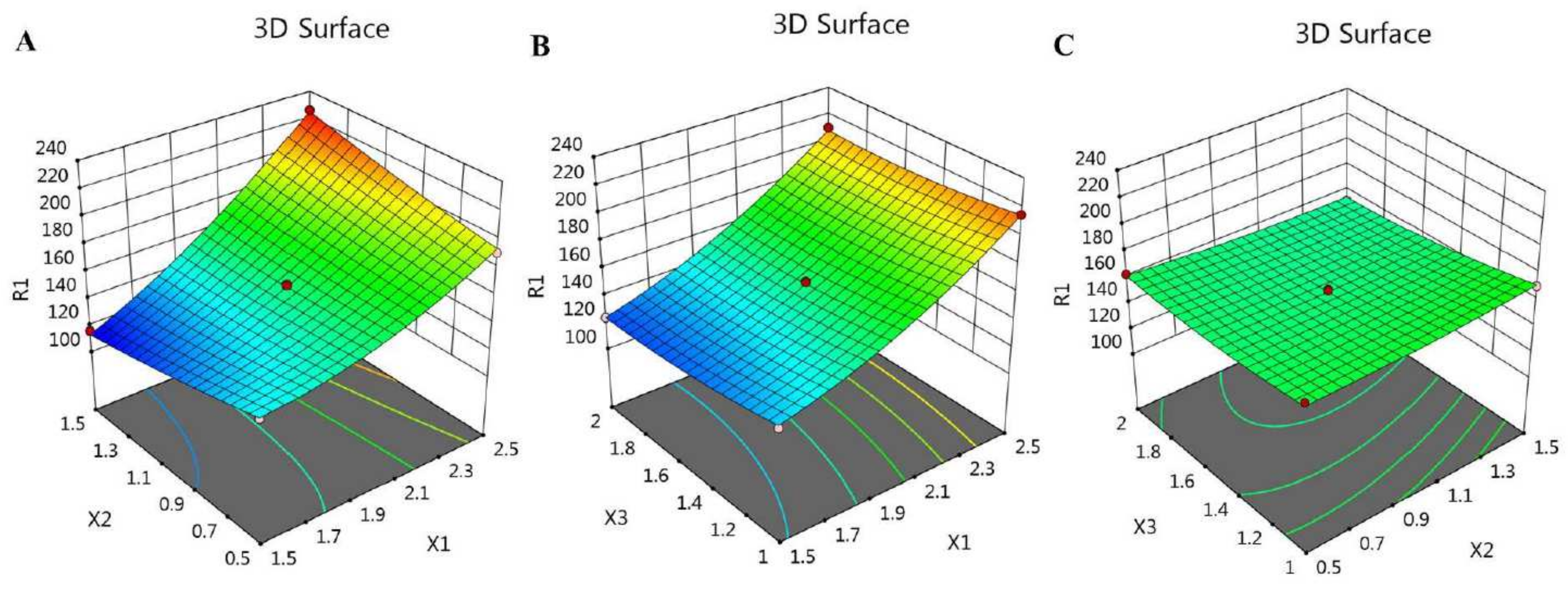
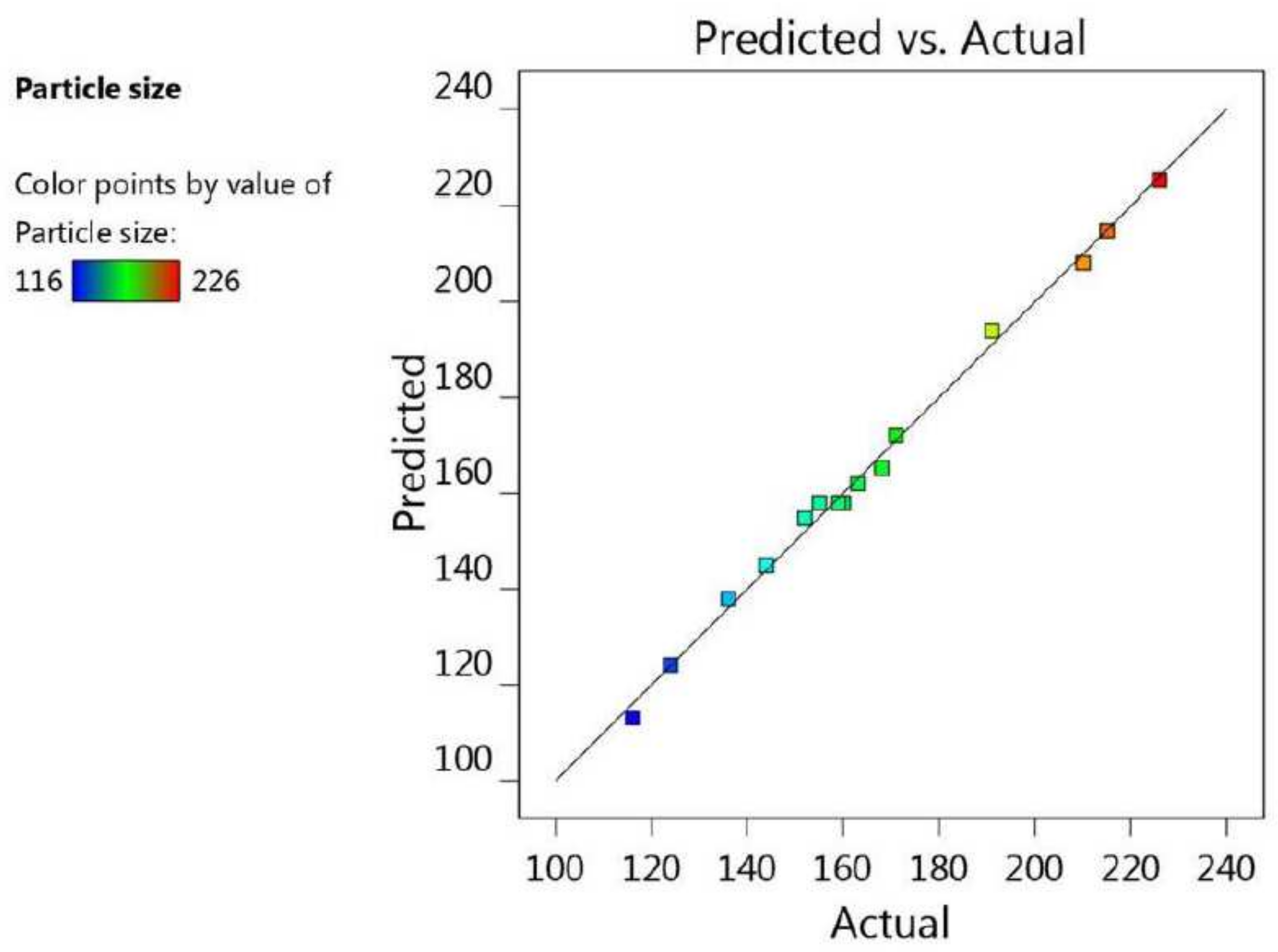

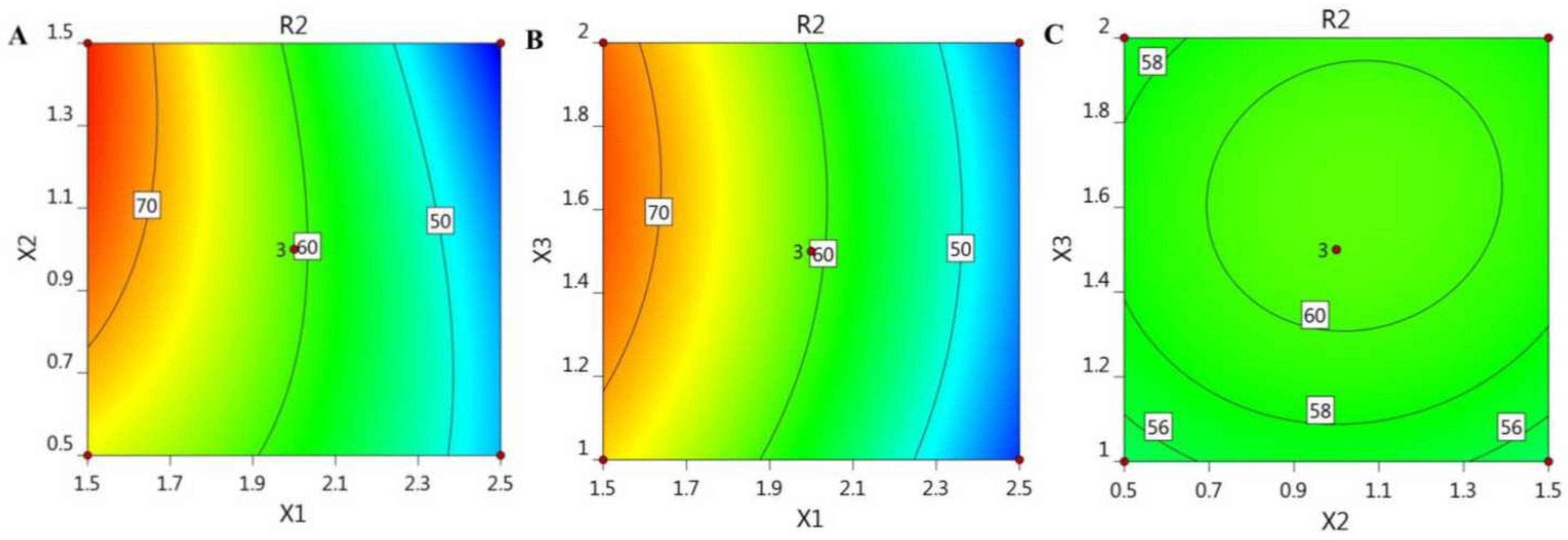
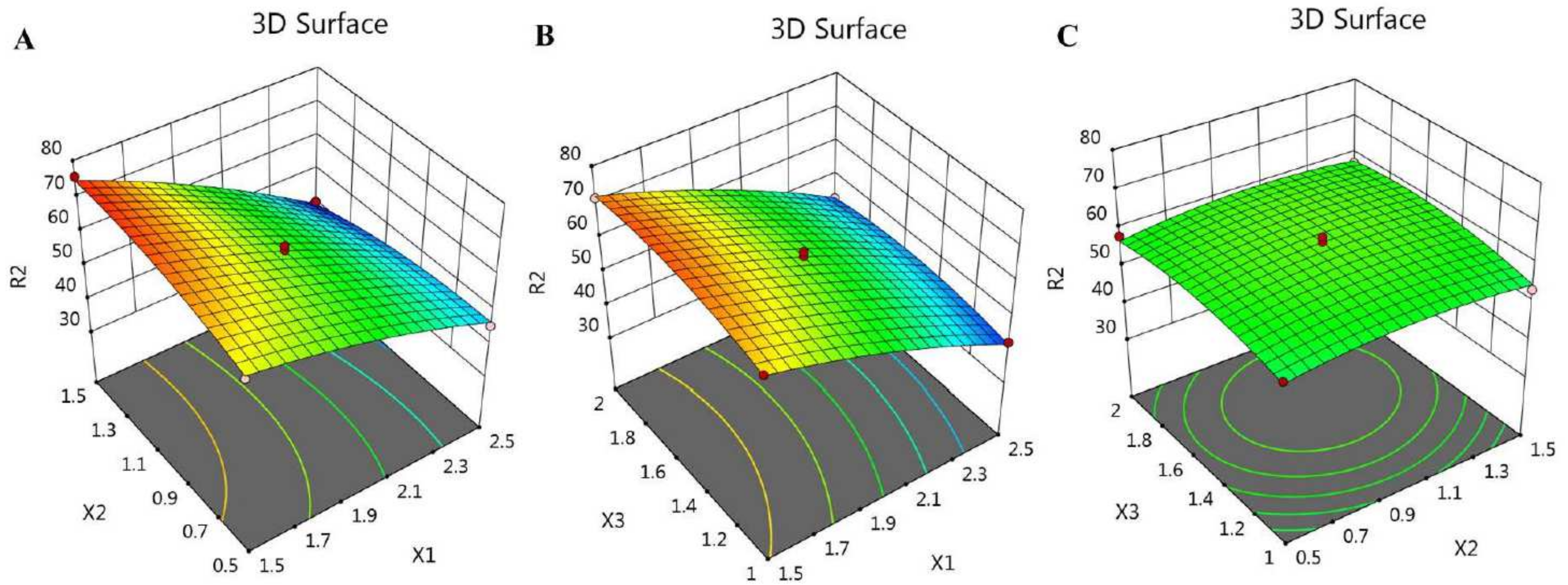



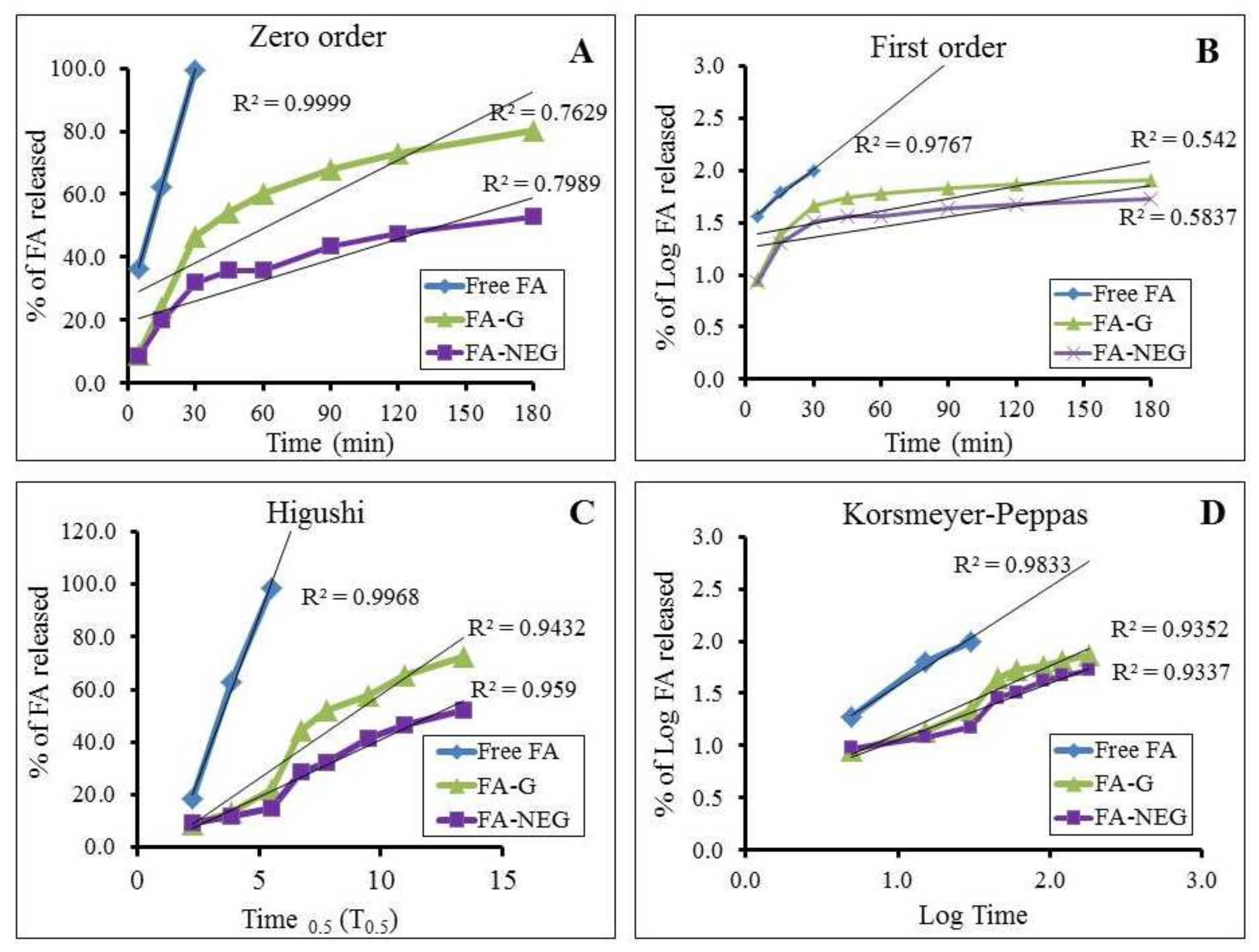
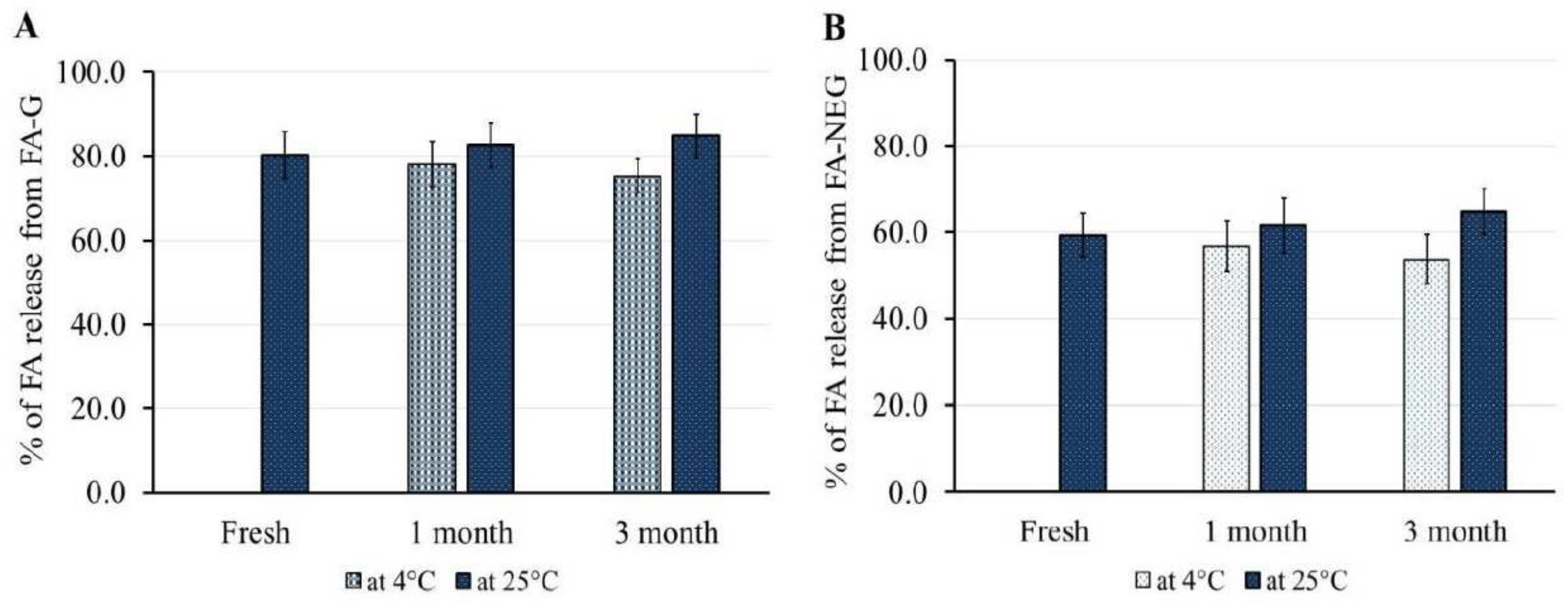


| Source | R1 | R2 | ||
|---|---|---|---|---|
| F-Value | p-Value | F-Value | p-Value | |
| Model | 144.14 | <0.0001 * | 71.67 | <0.0001 * |
| X1 | 1152.04 | <0.0001 * | 593.17 | <0.0001 * |
| X2 | 0.0111 | 0.9201 | 0.2627 | 0.6301 |
| X3 | 18.68 | 0.0076 * | 5.58 | 0.0646 * |
| X1X2 | 88.20 | 0.0002 * | 24.48 | 0.0043 * |
| X2X3 | 1.09 | 0.3445 | 0.6713 | 0.4499 |
| X3X1 | 4.36 | 0.0912 | 0.1946 | 0.6775 |
| X12 | 29.62 | 0.0028 * | 6.09 | 0.0567 |
| X22 | 1.01 | 0.3621 | 7.34 | 0.0423 * |
| X32 | 4.62 | 0.0844 | 10.40 | 0.0233 * |
| Lack of Fit | 2.01 | 0.3490 | 1.32 | 0.4580 |
| R2 analysis | ||||
| R² | 0.9962 | 0.9923 | ||
| Adjusted R² | 0.9892 | 0.9785 | ||
| Predicted R2 | 0.9517 | 0.9124 | ||
| Adequate Precision | 40.8966 | 27.1516 | ||
| Model | ||||
| Remark | Quadratic | Quadratic | ||
| Dependent Response | Predicted Values | Observed Values |
|---|---|---|
| R1 (nm) | 109.667 ± 3.35 | 113.6 ± 3.21 |
| R2 (%) | 75.0 ± 1.58 | 71.9 ± 2.65 |
| Formulation | Zero-Order Kinetic (r2) | First-Order Kinetic (r2) | Higuchi Kinetic (r2) | Korsmeyer–Peppas Kinetic (r2) |
|---|---|---|---|---|
| FA Suspension | 0.937 | 0.811 | 0.974 | 0.934 |
| FA-G | 0.756 | 0.521 | 0.893 | 0.861 |
| FA-NEG | 0.864 | 0.667 | 0.967 | 0.964 |
| Properties | Temperature | FA-G | FA-NEG | FA-G | FA-NEG |
|---|---|---|---|---|---|
| 1 Month | 3 Months | ||||
| Physical Inspection | 4 °C | No phase separation | No phase separation | No phase separation | No phase separation |
| 25 °C | |||||
| pH | 4 °C | 6.51 ± 0.29 | 6.70 ± 0.19 | 6.58 ±0.30 | 6.68 ± 0.20 |
| 25 °C | 6.41 ± 0.35 | 6.55 ± 0.20 | 6.54 ± 0.29 | 6.72 ± 0.27 | |
| Viscosity (cP) | 4 °C | 16,150 ± 736 | 26,090 ± 641 * | 16,720 ± 687 | 27,050 ± 589 * |
| 25 °C | 14,575 ± 566 | 24,510 ± 720 * | 14,050 ± 655 | 24,510 ± 720 * | |
| Spreadability (mm) | 4 °C | 39.3 ± 2.7 | 32.4 ± 2.5 * | 38.5 ± 2.6 | 31.7 ± 2.5 * |
| 25 °C | 41.2 ± 2.4 | 34.5 ± 1.9 * | 40.3 ± 2.4 | 34.5 ± 1.9 * | |
| Formula | SSTF µg/cm2·h | ER |
|---|---|---|
| Free FA | 35.9 ± 4.1 | 1 |
| FA-G | 68.7 ± 5.1 * | 1.91 ± 0.14 * |
| FA-NEG | 111.2 ± 4.5 * # | 3.10 ± 0.13 * # |
| Bacterial Type | Inhibition Zone (cm) | ||
|---|---|---|---|
| FA-NEG | Placebo NEG | FA Cream | |
| Bacillus subtilis | 3.6 ± 0.18 | 3.4 ± 0.19 | 2.8 ± 0.21 |
| Staphylococcus aureus | 4.4 ± 0.17 | 2.2 ± 0.10 | 3.9 ± 0.15 |
| Enterococcus faecalis | 3.1 ± 0.15 | 0.9 ± 0.08 | 2.5 ± 0.10 |
| Candida albicans | 2.2 ± 0.12 | 2.0 ± 0.14 | Negative |
| Shigella | 2.8 ± 0.16 | 2.7 ± 0.15 | Negative |
| Escherichia coli | 2.3 ± 0.10 | 1.7 ± 0.18 | Negative |
| Independent Variable | Symbol | Level of Variation | ||
|---|---|---|---|---|
| Lowest (−1) | Central (0) | Highest (1) | ||
| Oil Concentration (g) | A | 1.5 | 2.0 | 2.5 |
| Tween 80 (g) | B | 0.5 | 1.0 | 1.5 |
| Transcutol® P (g) | C | 1.0 | 1.5 | 2.0 |
| Dependent Variable | Symbol | Constraints | ||
| Particle Size (nm) | R1 | Minimize | ||
| In vitro release (%) | R2 | Maximize | ||
Publisher’s Note: MDPI stays neutral with regard to jurisdictional claims in published maps and institutional affiliations. |
© 2022 by the authors. Licensee MDPI, Basel, Switzerland. This article is an open access article distributed under the terms and conditions of the Creative Commons Attribution (CC BY) license (https://creativecommons.org/licenses/by/4.0/).
Share and Cite
Almostafa, M.M.; Elsewedy, H.S.; Shehata, T.M.; Soliman, W.E. Novel Formulation of Fusidic Acid Incorporated into a Myrrh-Oil-Based Nanoemulgel for the Enhancement of Skin Bacterial Infection Treatment. Gels 2022, 8, 245. https://doi.org/10.3390/gels8040245
Almostafa MM, Elsewedy HS, Shehata TM, Soliman WE. Novel Formulation of Fusidic Acid Incorporated into a Myrrh-Oil-Based Nanoemulgel for the Enhancement of Skin Bacterial Infection Treatment. Gels. 2022; 8(4):245. https://doi.org/10.3390/gels8040245
Chicago/Turabian StyleAlmostafa, Mervt M., Heba S. Elsewedy, Tamer M. Shehata, and Wafaa E. Soliman. 2022. "Novel Formulation of Fusidic Acid Incorporated into a Myrrh-Oil-Based Nanoemulgel for the Enhancement of Skin Bacterial Infection Treatment" Gels 8, no. 4: 245. https://doi.org/10.3390/gels8040245
APA StyleAlmostafa, M. M., Elsewedy, H. S., Shehata, T. M., & Soliman, W. E. (2022). Novel Formulation of Fusidic Acid Incorporated into a Myrrh-Oil-Based Nanoemulgel for the Enhancement of Skin Bacterial Infection Treatment. Gels, 8(4), 245. https://doi.org/10.3390/gels8040245







